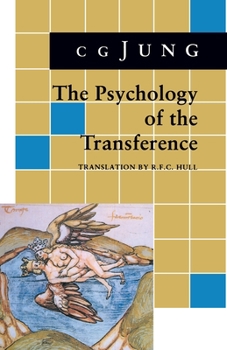Psychology of the Transference: (From Vol. 16 Collected Works)
Select Format
Select Condition 
Book Overview
Extracted from Volume 16. An authoritative account, based on a series of 16th century alchemical pictures, of Jung's handling of the transference between analyst and patient.
Format:Paperback
Language:English
ISBN:0691017522
ISBN13:9780691017525
Release Date:June 1969
Publisher:Princeton University Press
Length:232 Pages
Weight:0.59 lbs.
Dimensions:0.6" x 5.5" x 8.4"
Customer Reviews
2 ratings
The Apex, Not The Ape
Published by Thriftbooks.com User , 23 years ago
The penultimate title in C.G. Jung's 20 - volume Collected Works, The Psychology of the Transference is a short, seemingly complex book which readily rewards the reader who perseveres and is unintimidated by Jung's lengthy sentences, the alchemical illustrations, or the numerous passages in Latin. Jung's subject is his discovery that the "great work" of the 16th and 17th century alchemists -- a search for the 'philosopher's stone' of 'psychic wholeness' (as opposed to 'psychic perfection') -- corresponds closely to the psychological process of the transference (a dynamic set of duo projections of unconscious psychic contents). The alchemical process mysteriously corresponds not only the transference possible between psychologist and patient, but between any two individuals who spontaneously (unconsciously) constellate some part of the other's psyche through normal human interaction. However, as with all of Jung's later work, the book's larger focus is the psychic evolution of the individual. The Psychology of the Transference's pivotal message is that the process of cautiously evolving one's consciousness to the hypothetical point of `individuation' or `integration,' is primarily a moral and ethical one. The book stresses that it is also a critically necessary process, however painful and potentially dangerous. In Jung's estimation, mankind has no choice but to accept the challenge of psychic evolution: the alternative is a perpetual present state of misunderstanding, hatred, suspicion, bigotry, oppression, war, and genocide. Like Freud, Jung believed that man's psyche contains an enormous multi-tier unconscious reservoir, one which not only dwarfs man's generally narrow consciousness but is also the matrix in which consciousness originated (thus the alchemical motto "high rests on low"). The unconscious is the original abode of all drives, demons, and daimons, all instincts and angels, all creativity and appetites for destruction. Since many of its contents are unacceptable to modern man -- the most foundational of these being the incest complex - these damned and rejected contexts are not and cannot be readily integrated into consciousness. Instead, they are spontaneously projected outward onto other human beings, social classes, institutions, and countries -- onto any 'object' that is perceived as other and different from the self. No man can evolve his consciousness without first becoming aware of and retracting these projections and learning to comfortably accept them as his own dark potentialities. It is not simply of matter of leaving the instinctual man behind, but of learning to integrate the necessary if often unattractive instinctual and vital functions into consciousness before moving forward. Thus the process is one of refinement and accumulation and not one of elimination. Only the first major step in a series (Emerson: "Every ultimate fact is only the first of a new series"), the confrontation with and integration of the '
Alchemy and the Psychology of Inner Redemption
Published by Thriftbooks.com User , 25 years ago
Yes, "transference" was originally Freud's term, but Jung's use in this 1946 essay is expanded far beyond what Freud (or anyone practicing psychology today) could possibly recognize. For Jung, transference was about a person's relation with his or her Unconscious, and the spectrum of possible relationships extends from delusion to liberating insight. Thus, transference is not just about the patient's relationship to the therapist; rather, transference is ultimately about the individual's relationship with the whole of life. After an introductory section, Jung frames his essay as a commentary on the *Rosarium Philosophorum*, an alchemical text published in 1550. The text focuses on a series of ten drawings that will assuredly appear bizarre to folks unfamiliar with alchemical symbols; however, Jung's brilliant analysis demonstrates that these apparently monstrous images actually map out, symbolically, that path to inner liberation. Indeed, this essay, late in Jung's career, represents him at the height of his powers, synthesizing symbols from a variety of sources to create a text dense with insights into the fundamental problems of human life.





